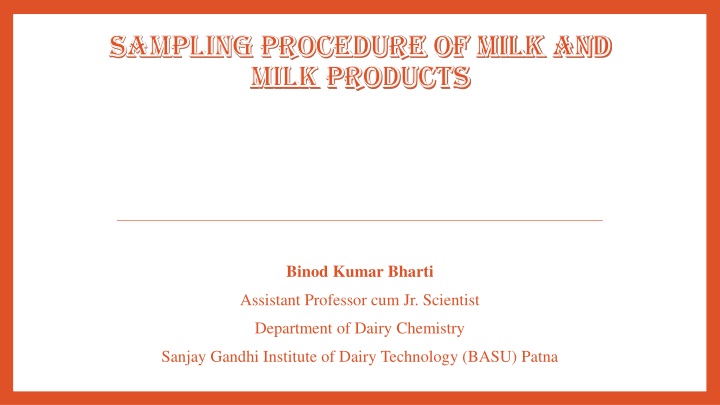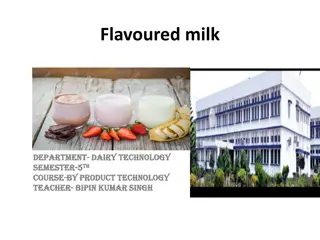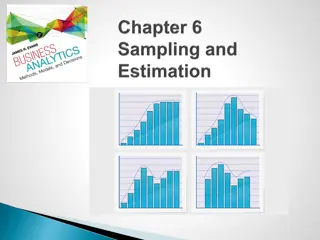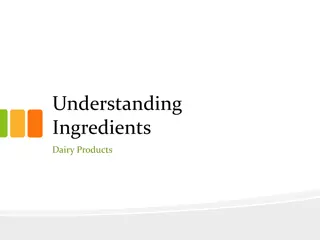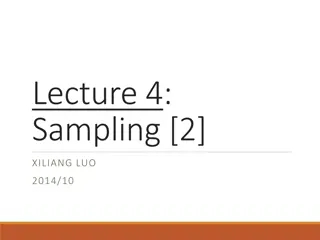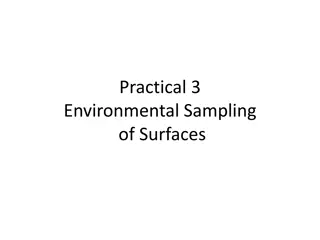Proper Sampling Procedure of Milk and Milk Products
Proper sampling of milk and milk products is crucial for accurate chemical analysis. This article covers the sampling procedures for various dairy products like milk, cream, paneer, ghee, and more. It emphasizes the importance of experienced personnel, sterile equipment for bacteriological testing, and ensuring samples are representative of the bulk product through thorough mixing techniques.
Download Presentation

Please find below an Image/Link to download the presentation.
The content on the website is provided AS IS for your information and personal use only. It may not be sold, licensed, or shared on other websites without obtaining consent from the author.If you encounter any issues during the download, it is possible that the publisher has removed the file from their server.
You are allowed to download the files provided on this website for personal or commercial use, subject to the condition that they are used lawfully. All files are the property of their respective owners.
The content on the website is provided AS IS for your information and personal use only. It may not be sold, licensed, or shared on other websites without obtaining consent from the author.
E N D
Presentation Transcript
SAMPLING PROCEDURE OF MILK AND SAMPLING PROCEDURE OF MILK AND MILK PRODUCTS MILK PRODUCTS Binod Kumar Bharti Assistant Professor cum Jr. Scientist Department of Dairy Chemistry Sanjay Gandhi Institute of Dairy Technology (BASU) Patna
CONTENTS CONTENTS 1. Introduction 2. General requirements while sampling 3. Sampling of Milk 4. Sampling of Cream 5. Sampling of Paneer/Cheese/Chhana 6. Sampling of khoa 7. Sampling of Ghee 8. Sampling of Butter 9. Sampling of Ice Cream 10. Sampling of condensed milk 11. Sampling of Powder
INTRODUCTION INTRODUCTION Proper sampling of milk and milk products is the first step in performing an accurate chemical analysis of its constituents. All errors in chemical and microbiological analysis begins with the sampling procedure. Sampling of milk and milk products is a specific job and shall be done by an experienced person who is familiar with the techniques and is well acquainted with the knowledge of the subject. Sampling may be required for chemical and bacteriological testing. All precautions shall be taken to prevent contamination and adulteration. It is not possible to lay down a single sampling procedure which will be applicable in all the cases. The method of sampling will vary according to the purpose for which the sample is collected and the tests which are to be carried out. The sample should be taken in random a manner as possible to give each container or package an equal chance of being selected.
For chemical examination, the sampling equipment like plunger, sample bottle, rubber stopper shall be clean and dry. For bacteriological examination, all equipments including plunger, sample bottles and rubber stoppers shall be sterile and the samples shall be collected under aseptic conditions. If subsequent analysis is to be of some value, it is very important that sample should be a true representative of the bulk. Milk fat is of lower density than the other constituents of milk, it has tendency to rise to the surface. Therefore, thorough mixing of milk with a proper instrument which will reach the entire depth of the liquid is essential to ensure that a representative samples of the entire batch.
A sample is the small portion of a product representing the entire batch or lot of samples. The composite sample is the quantity secured by mixing together proportional parts of different lots of a product. There are maximum accuracy in analytical value if the sampling is done carefully. In small batches, it should be possible to accomplish mixing by pouring the entire quantity of milk from one container to another container, three or four times. Larger batches of milk samples shall be thoroughly agitated by a hand stirrer or by mechanical process. Milk churns easily at temperature between 26.5 to 29.5 C and agitation near this temperature shall be avoided.
GENERAL REQUIREMENTS WHILE SAMPLING GENERAL REQUIREMENTS WHILE SAMPLING Sample shall be drawn by an experienced person in a protected place not exposed to damp, air, bright light, dust, soot or smoke particles, rain etc. The sample temperature while sampling should be between 0 to 15 C. If sample is to be transported, the sample temperature should be maintained between 0-7 C (for ice cream - 15 C) Precautions shall be taken to protect the samples, the material being samples, the sampling instruments and containers for sample from adventitious contamination and adulteration. The sampling instruments and sample containers shall be clean, dry and shall not impart any foreign odour, or flavour.
The sampling appliances used shall be of stainless steel (SS) or of suitable material and shall be light in weight for the operator to be able to move them rapidly through the product. All the surfaces of sampling appliances shall be rounded. The sample containers shall be of such size that sufficient head space is allowed for expansion at the top. At the same time, this space should not be too large as air exerts detrimental action. Each container shall be sealed air tight after filling and marked with full details of sampling or code number, name and address of manufacturer and other important consignment. Plunger Sampling bottle Dipper
CARE OF SAMPLES CARE OF SAMPLES The samples shall be sent to the examining laboratory as soon as possible, and it shall be analysed without delay. If not possible, the sample(s) shall be stored in a refrigerated temperature 0 to 5 C, where this is not possible, then adequate precautions shall be taken to prevent deterioration and exposure to high temperature and light. In some cases, preservative may be added to prevent deterioration and it does not interfere with the subsequent analysis. The preservative added shall be indicated on the label of sample botles. According to FSSAI (2015), the preservative used in the case of sample of milk, in liquid form commonly known as formalin i.e. Formalin containing about 40 per cent of formaldehyde in aqueous solution in proportion of 0.4 ml (two drops) for 100 ml or 100 grams.
SAMPLING PROCEDURES SAMPLING PROCEDURES Milk The sample collected for chemical analysis should be representative of the entire batch of milk that is being sampled. Milk fat is of lower density than the other constituents of milk, so it tends to rise to the surface. Through mixing of milk with a proper instrument which will reach the entire depth of the liquid is essential. Milk churns easily at 26.5 to 29.5 C and agitation near this temperature shall be avoided. The samples can be preserved with formalin (0.1ml (two drops) for 25 ml of milk), or potassium dichromate (0.06 g/100 ml, for instrumental methods), or mercuric chloride (0.5g/250 ml milk, cryoscopic examination) solution.
SAMPLING OF INDIVIDUAL CONTAINER SAMPLING OF INDIVIDUAL CONTAINER Pour the milk from one container to another, three or four times. Where this is not practicable, mix thoroughly with a plunger. In mixing the milk, the plunger shall be allowed to fall to the bottom of the container and brought to the top of the milk as rapidly as possible not less than 10 times. The position of the plunger shall also be moved from place to place to ensure that the whole of the milk at the bottom of the vessel is thoroughly agitated and mixed with the upper layer. Any milk fat adhering to the neck and under the shoulder of the can shall be well mixed with the remain of the milk. After thorough mixing, a sample shall be drawn immediately.
SAMPLING OF SEVERAL CONTAINERS SAMPLING OF SEVERAL CONTAINERS The sample shall be taken after pouring the contents of the containers into a vat and mixing it. When this is not possible, a composite sample is taken from the containers after milk has been agitated and mixed. The following steps are followed:- First, the milk shall be distributed as equally as possible among a number of containers. The cans shall not be filled, but the same quantity shall be placed in each. After mixing the contents of each can thoroughly, an equal volume of milk shall be taken from each. These portions shall be placed in another vessel, thoroughly mixed as described in case of individual container and a sample then taken. A composite sample may be obtained by taking the same proportion of the milk therein from each container in a consignment after thorough mixing, collecting this in another vessel and taking a sample as described in case of individual container.
SAMPLING FROM STORAGE TANKS , RAIL & ROAD MILK TANKERS SAMPLING FROM STORAGE TANKS , RAIL & ROAD MILK TANKERS The method of sampling of milk from storage tanks/rail/ road tankers is largely governed by storage/transport conditions. In all cases, the milk in the tank and tanker shall be thoroughly mixed by large plunger, a mechanical agitator; the uniformity of the samples being determined, when necessary, by mixing till such time as complete agreement is obtained between samples taken at the manhole and at the outlet cock in respect of fat and total milk solids. When a plunger is used for mixing the milk in rail/road milk tankers, a satisfactory method is to insert the plunger in the man-hole, the operator sitting or standing on top of the tanker. The plunger is thrust forward and pulled back, thrust downwards and pulled back and thrust backwards and pulled back. The cycle of this operations should be repeated for at least 15 minutes. After proper mixing of the milk, the sample should taken from the tank, removed through the stopcock in the tank door, or from a valve on the discharge line from the tank when it is being emptied.
COMPOSITE MILK SAMPLES FOR FAT TEST COMPOSITE MILK SAMPLES FOR FAT TEST Suppliers of milk are often paid for milk on the basis of milk fat test. The determination of fat contents of the suppliers daily deliveries is laborious and expensive. Therefore, composite samples of the suppliers milk are taken over a period and then tested. After thorough mixing, proportionate amounts of the suppliers daily delivery are collected and placed into the patron s composite sample bottle. The total volume of the individual composite sample shall be not less than 175 ml. The bottle containing the composite milk sample shall be tightly stoppered to prevent evaporation and kept in a freeze, away from light, till required for analysis. The sample shall be analyzed on the same day as the last portion of milk is transferred to the composite sample bottle.
TREATMENT OF MILK SAMPLE TREATMENT OF MILK SAMPLE Warm the milk samples in the bottle to about 40 C in a water bath and mix thoroughly. Cool it to 26 - 28 C. Leave aside the samples for about 4-5 minutes after mixing to allow air bubbles to rise and escape. After that, mix the sample by inverting the bottle 3-4 times and start analysis.
CREAM CREAM Sampling from Individual, Several, Bulk Containers The sampling procedure followed for milk like in individual, several or bulk containers can be applied to cream. When samples of cream is thin and in small containers, it shall be mixed by plunging not less than 10 times. It is essential that whole cream should be thoroughly agitated and to mixed. For thick cream, plunger can be used for proper mixing. To avoid whipping and churning, the disc of the plunger shall not be brought above the surface of the cream.
PREPARATION OF CREAM SAMPLE When cream is thin and in small containers, it shall be mixed by plunging atleast ten times. The position of the plunger shall be moved from place to place to ensure that the whole of the cream at the bottom of the vessel has been thoroughly agitated and mixed with the upper layer. To avoid whipping and churning, the disc of the plunger shall not be brought above the surface of the cream. When cream is thick or in bulk containers, it shall be mixed by plunging as same for thin cream. When the cream is sour, the material shall be warmed so as to attain a temperature between 30 and 40 C and, while cooling it to room temperature, the container shaken gently or the contents stirred. Keep the contents covered as much as possible. In all cases the sample of cream shall be taken immediately after mixing.
SAMPLING OF PANEER/CHEESE/CHHANA SAMPLING OF PANEER/CHEESE/CHHANA One of the following methods are employed during sampling- 1. Sampling by cutting a sector-Using a knife with a sharp blade, two random cuts are made radially proceeding from the centre of the cheese/paneer towards the edge. 2. Sampling by means of a trier- The cheese trier is driven obliquely into the surface of the paneer or cheese towards the centre once or several times at a point at least 10 to 20 cm from the edge of the cheese. 3. However, when the cheese is delivered in drums, or other larger containers, sampling may be carried out by driving the trier obliquely through the content of the container from the top to bottom. This method is suited for sampling of processed cheese.
PREPARATION OF PANEER/CHEESE/CHHANA SAMPLE FOR ANALYSIS Samples shall be prepared for chemical analysis by passing them quickly through a suitable grater, by grinding them quickly in a mortar and returning them to the sample container or by cutting them into small pieces with a sharp knife in the container. Sampling by cutting Use knife with a pointed blade Circular base Make two cuts radiating from the centre of the cheese, when cheese is circular in shape, after removing the inedible portion sample should be minimum 150 gm. Rectangular base Make cuts parallel to the sides. After removing the inedible portion sample should be minimum 150 gm.
SAMPLING OF KHOA SAMPLING OF KHOA The sampling of khoa follows the procedure used for sampling cheese/paneer/chhana, except that a clean dry stainless steel knife with sharp pointed blade is used to cut khoa for sampling.
SAMPLING OF GHEE Bulk Units The number of containers to be selected for sampling shall depend upon the lot size. A random sampling procedure can be adopted for uniform quality of ghee as given below: Number of containers in the lot Number of containers to be selected 1 1 2-40 2 41-110 3 111-300 5 301-600 7 601 and above 10 If there is a possibility of wide variation among the different lots, e.g. in the consignment from an individual producer, every unit shall be sampled. A composite sample is prepared by taking equal amount of ghee from each of the container selected.
PREPARATION OF GHEE SAMPLE For determination of moisture and organoleptic test sample is mixed without heating in the container itself until homogeneous stage. For sensory evaluation, a little quantity of ghee is taken on back palm of one hand and is lightly rubbed with the help of the other hand. During this process, the aromatic constituents released due to friction and body heat are inhaled. In addition or alternatively, a few drops of melted ghee are put on the tongue for taste. After the determination of moisture, sample is heated in a water bath to a temp. not higher than 50 C till completely melted. It is filtered and clear and it is used for general analysis.
SAMPLING OF BUTTER Bulk Units If the butter is supplied in bulk units like boxes, a random sampling procedure shall be followed as given below. Number of units in the lot No. of units to be selected 1 1 2-9 2 10-49 3 50-99 4 100-199 5 Over 200 5 for the first 200 units or by a fraction thereof. 200 + 1 for each additional
PREPARATION OF BUTTER SAMPLE PREPARATION OF BUTTER SAMPLE The sample is warmed to a temperature not exceeding 39 C or at the lowest possible temperature in an oven or water-bath until by vigorous shakings a homogenous fluid emulsion is obtained. For butter fat analysis, a portion of emulsified butter is heated to 50 to 60 C until the fat separates. The fat layer is filtered through a dried filter paper above solidification point of fat by using hot water funnel. Clear filtrate free from water is used after mixing for analysis of butter.
ICE ICE- -CREAM CREAM Bulk Units If the product is supplied in bulk units, the number of units to be selected for sampling shall normally be as follows: Total no. of units No. of units to be selected 1 1 2 to 5 2 6 to 20 3 21 to 60 4 61 to 100 5 over 100 5 + one for each additional 100 units. When there is a possibility of wide variations between different units, every units shall be sampled.
PREPARATION OF SAMPLE OF ICE-CREAM The samples shall be stored at a temperature (not higher than -15 C). During transit the samples shall be maintained at a temperature not exceeding -15 C. Sample size of ice-cream shall not be less than 100 g. If necessary several packages of smaller size shall be taken to make up the required size of sample. In multilayered ice-cream, the sample shall be such as to contain the same proportion of each layer as is present in the original ice-cream. Different layers shall not be separated at the time of sampling and a complete sample of all layers shall be placed in the sample jar. For the purpose of melting, the frozen sample may be kept at room temperature or, if required, in water bath at a temperature not exceeding 45 C for not more than 15 minutes. Thoroughly mix the Ice-Cream samples before removal of the test portion.
SAMPLING OF CONDENSED MILKS SAMPLING OF CONDENSED MILKS Bulk Units If the consignment is declared to consist of different batches of manufacture, the batches shall be marked separately and the groups of containers in each batch shall constitute separate lots. The containers from the lot shall be chosen at random and to ensure the randomness of selection, a random number table as agreed to between the purchaser and the vendors shall be used. Lot size No. of containers to be selected 50 - 300 6 301 - 500 12 501 - 1000 15 1000 - and above 21 The sample containers selected shall be divided at random into three equal sets and labeled with all the particulars of sampling.
PREPARATION OF SAMPLE OF CONDENSED MILK PREPARATION OF SAMPLE OF CONDENSED MILK On storage of condensed milk, separation of the constituents such as fat, lactose may occur. It is necessary to mix the contents of the container prior to analyses in the following manner: Heat the container in a water bath at about 40 C until the sample has nearly reached this temperature. Open the container at the edge of the lid. Re-incorporate all the material adhering to the lid into the container. Mix the contents thoroughly by stirring with a spoon or spatula, in such a way that the top layers as well as contents of the lower corners are moved and mixed. Repeat the stirring before drawing the sample for testing various parameters.
THANK YOU THANK YOU
